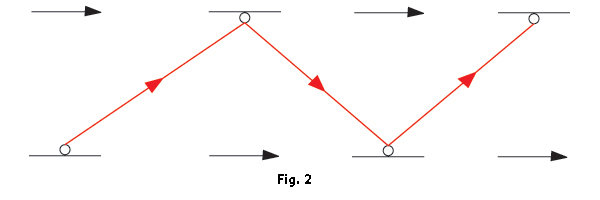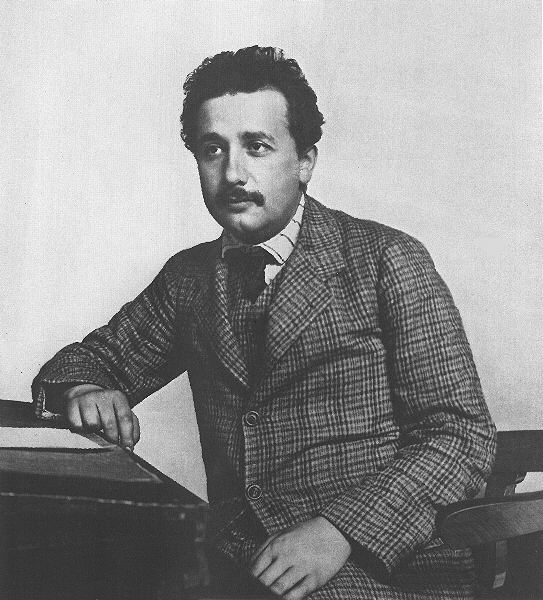 One hundred years ago this month, twenty-six-year-old Albert Einstein published a paper entitled “Zur Elektrodynamik bewegter Körper“ or “On the Electrodynamics of Moving Bodies”. As we all know by now, 1905 was Einstein’s annus mirabilis, the miraculous year in which he published four papers in the Annalen der Physik. The first was a paper on the photoelectric effect; the second on Brownian motion; and the third, which we have already mentioned, spelled out the ideas which would come to be known as special relativity. In case you are less than sure why Einstein’s name has become a metonym for extreme intelligence, consider that there is broad consensus among physicists that any one of these three papers by itself would have been more than enough to win Einstein a Nobel Prize. The fourth paper, by the way, used the axioms of the third to derive a nice little result equating energy and mass: E = mc2, probably the most famous equation of all time. Not only that, he would certainly have won another Nobel for general relativity, which he published a decade later. In other words, you can safely think of Einstein as someone who, in a fairer world, would have been at least a four-time Nobel winner. As it is, the Nobel committee cited only the photoelectric effect when they awarded him the prize in 1921.
One hundred years ago this month, twenty-six-year-old Albert Einstein published a paper entitled “Zur Elektrodynamik bewegter Körper“ or “On the Electrodynamics of Moving Bodies”. As we all know by now, 1905 was Einstein’s annus mirabilis, the miraculous year in which he published four papers in the Annalen der Physik. The first was a paper on the photoelectric effect; the second on Brownian motion; and the third, which we have already mentioned, spelled out the ideas which would come to be known as special relativity. In case you are less than sure why Einstein’s name has become a metonym for extreme intelligence, consider that there is broad consensus among physicists that any one of these three papers by itself would have been more than enough to win Einstein a Nobel Prize. The fourth paper, by the way, used the axioms of the third to derive a nice little result equating energy and mass: E = mc2, probably the most famous equation of all time. Not only that, he would certainly have won another Nobel for general relativity, which he published a decade later. In other words, you can safely think of Einstein as someone who, in a fairer world, would have been at least a four-time Nobel winner. As it is, the Nobel committee cited only the photoelectric effect when they awarded him the prize in 1921.
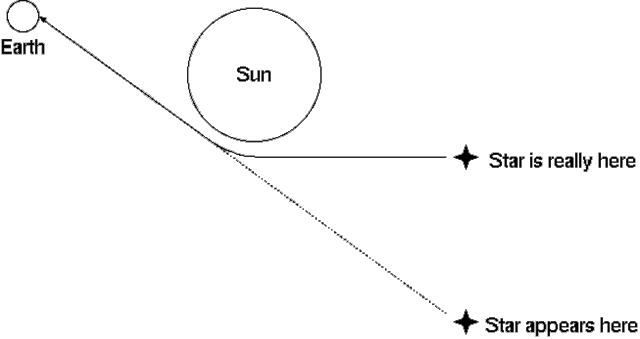 Einstein’s results were disseminated and understood so slowly (especially in the English-speaking world) that when Sir Arthur Eddington lead an expedition to prove general relativity correct by showing that the light from stars near the Sun in the sky would be bent by its gravity (during a solar eclipse in 1919 when you could actually see stars close to the Sun), and a journalist asked him: “Is it true that only three people in the world understand relativity?” Eddington reportedly responded, “Who’s the third?”
Einstein’s results were disseminated and understood so slowly (especially in the English-speaking world) that when Sir Arthur Eddington lead an expedition to prove general relativity correct by showing that the light from stars near the Sun in the sky would be bent by its gravity (during a solar eclipse in 1919 when you could actually see stars close to the Sun), and a journalist asked him: “Is it true that only three people in the world understand relativity?” Eddington reportedly responded, “Who’s the third?”
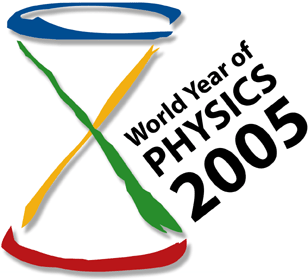 This year has been declared the World Year of Physics in commemoration of the centennial of Einstein’s annus mirabilis, and in that same spirit, I would like today to attempt to give you a sense of what the theory of special relativity (SR) is, whose 100th birthday we celebrate this month. Most of you have at least some vague idea of what SR implies: you have heard that time slows down when you start traveling very fast (near the speed of light); that lengths contract; and almost everyone knows the Twin Paradox, where one twin travels out into space at high speed, then returns, say 6 years later to find that her twin on earth has aged 39 years while she was gone. You have probably also heard that Einstein is responsible for inextricably entwining space and time into spacetime. I will explicate all these aspects of SR, and I will not do it by using crude analogies, which tend to confuse more than they illuminate; instead, I will use the actual math so that you fully understand the beauty of this theory. Wait! Don’t stop reading just yet. The math required is no more than simple high school algebra, so if you remember how to do that, stay with me. If the sight of even the simplest equation makes you tremulous, then I can only say: learn some math! Einstein himself famously stated that “The presentation of science to the public must be made as simple as possible, but not more so,” and we cannot but follow his dictum here, where our very aim is to celebrate his science. (The beauty of SR lies in the incredible conceptual leap which Einstein made. The mathematics is relatively (!) straightforward, and this is what makes my elucidation of it possible. The mathematics of general relativity is much more advanced, indeed far beyond the abilities of most people who, like me, are neither mathematicians nor physicists. Even Einstein needed some help from mathematicians to work it all out.)
This year has been declared the World Year of Physics in commemoration of the centennial of Einstein’s annus mirabilis, and in that same spirit, I would like today to attempt to give you a sense of what the theory of special relativity (SR) is, whose 100th birthday we celebrate this month. Most of you have at least some vague idea of what SR implies: you have heard that time slows down when you start traveling very fast (near the speed of light); that lengths contract; and almost everyone knows the Twin Paradox, where one twin travels out into space at high speed, then returns, say 6 years later to find that her twin on earth has aged 39 years while she was gone. You have probably also heard that Einstein is responsible for inextricably entwining space and time into spacetime. I will explicate all these aspects of SR, and I will not do it by using crude analogies, which tend to confuse more than they illuminate; instead, I will use the actual math so that you fully understand the beauty of this theory. Wait! Don’t stop reading just yet. The math required is no more than simple high school algebra, so if you remember how to do that, stay with me. If the sight of even the simplest equation makes you tremulous, then I can only say: learn some math! Einstein himself famously stated that “The presentation of science to the public must be made as simple as possible, but not more so,” and we cannot but follow his dictum here, where our very aim is to celebrate his science. (The beauty of SR lies in the incredible conceptual leap which Einstein made. The mathematics is relatively (!) straightforward, and this is what makes my elucidation of it possible. The mathematics of general relativity is much more advanced, indeed far beyond the abilities of most people who, like me, are neither mathematicians nor physicists. Even Einstein needed some help from mathematicians to work it all out.)
THE BACKGROUND
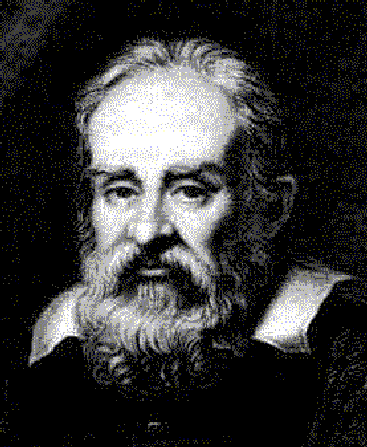 A century ago, this was the situation: Galilean and Newtonian physics said that any descriptions of motion by any two inertial observers (for such observers, bodies acted on by no forces move in straight lines) in uniform (not accelerating) relative motion are equally valid, and the laws of physics must be exactly the same for both of them. Bear with me here: what this means is, for example, if you see me coming toward you at a speed of 100 mph, then we could both be moving toward each other at 50 mph, or I could be still and you could be moving toward me at 100 mph, or I could be moving toward you at 30 mph while you are coming at me at 70 mph, and so on. All these descriptions are equivalent, and it is always impossible to tell whether one of us is “really” moving or not; all we can speak about is our motion relative to each other. In other words, all
A century ago, this was the situation: Galilean and Newtonian physics said that any descriptions of motion by any two inertial observers (for such observers, bodies acted on by no forces move in straight lines) in uniform (not accelerating) relative motion are equally valid, and the laws of physics must be exactly the same for both of them. Bear with me here: what this means is, for example, if you see me coming toward you at a speed of 100 mph, then we could both be moving toward each other at 50 mph, or I could be still and you could be moving toward me at 100 mph, or I could be moving toward you at 30 mph while you are coming at me at 70 mph, and so on. All these descriptions are equivalent, and it is always impossible to tell whether one of us is “really” moving or not; all we can speak about is our motion relative to each other. In other words, all  motion is relative to something else (which is then the inertial frame of reference). So for convenience, we can always just insist that any one observer is still (she is then the “frame of reference”) and all others are in motion relative to her. This is known as the Principle of Relativity. Another way to think about this is to imagine that there are only two objects in the universe, and they are moving relative to one another: in this situation it is more clearly impossible to say which object is moving. (Think about this paragraph, reread it, until you are pretty sure you get it. Just stay with me, it gets easier from here.)
motion is relative to something else (which is then the inertial frame of reference). So for convenience, we can always just insist that any one observer is still (she is then the “frame of reference”) and all others are in motion relative to her. This is known as the Principle of Relativity. Another way to think about this is to imagine that there are only two objects in the universe, and they are moving relative to one another: in this situation it is more clearly impossible to say which object is moving. (Think about this paragraph, reread it, until you are pretty sure you get it. Just stay with me, it gets easier from here.)
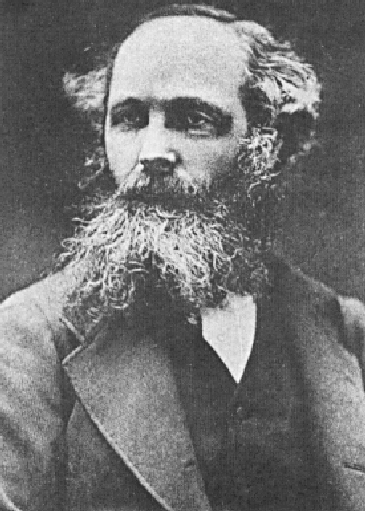 At the same time, James Clerk Maxwell‘s equations of electricity and magnetism implied that the speed of light in a vacuum, c, is absolute. The only way that this could be true is if Maxwell’s equations refer to a special frame (see previous paragraph) of reference (that in which the speed of light is c) which can truly be said to be at rest. If this is the case, then an observer moving relative to that special frame would measure a different value for c. But in 1887, Michelson and Morley proved that there is no such special frame. Another way of saying this (and this is the way Einstein put it in 1905) is that the speed of light is fixed, and is independent of the speed of the body emitting it. (The details of the Michelson-Morley experiment are beyond the scope of this essay, so you’ll have to take my word for this.)
At the same time, James Clerk Maxwell‘s equations of electricity and magnetism implied that the speed of light in a vacuum, c, is absolute. The only way that this could be true is if Maxwell’s equations refer to a special frame (see previous paragraph) of reference (that in which the speed of light is c) which can truly be said to be at rest. If this is the case, then an observer moving relative to that special frame would measure a different value for c. But in 1887, Michelson and Morley proved that there is no such special frame. Another way of saying this (and this is the way Einstein put it in 1905) is that the speed of light is fixed, and is independent of the speed of the body emitting it. (The details of the Michelson-Morley experiment are beyond the scope of this essay, so you’ll have to take my word for this.)
Now we have a problem. We have two irreconcilable laws: 1) The Principle of Relativity, and 2) The absoluteness of the speed of light for all observers. They cannot both be true. It would be another eighteen years before a young clerk in the Swiss patent office would pose and then resolve this problem. Here’s how he did it: he asked what would happen if they were both true.
Next, I will show how the various aspects of SR fall straight out of the assumption that both of these laws are true. I will focus in greater detail on the slowing down (dilation) of time, and then speak more briefly about length contraction, and the intertwining of space and time.
TIME DILATION
As I have mentioned, Einstein began by assuming that the following two postulates always hold true:
1) The Principle of Relativity, and
2) The speed of light will always be measured as c by all observers
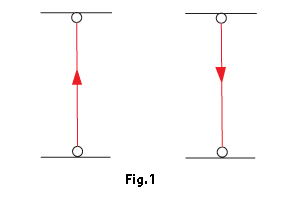 Now, keeping these in mind, let us consider a simple mechanism that we will call a light clock (shown in Fig. 1). The way it works is this: the top and bottom surfaces are perfect mirrors. The distance between the top and bottom mirror is known exactly. The light clock’s period is the time that it takes light to go from the bottom to the top, and then to come reflected back. Since the mirrors are perfect, light will keep on bouncing back and forth like this forever. All observers can build identical clocks with exactly the same distance between the two mirrors, ensuring the same period. And since the speed of light is always c, and the distance between the two mirrors can be measured precisely, we know exactly how long one “tick” or period of the clock is in seconds.
Now, keeping these in mind, let us consider a simple mechanism that we will call a light clock (shown in Fig. 1). The way it works is this: the top and bottom surfaces are perfect mirrors. The distance between the top and bottom mirror is known exactly. The light clock’s period is the time that it takes light to go from the bottom to the top, and then to come reflected back. Since the mirrors are perfect, light will keep on bouncing back and forth like this forever. All observers can build identical clocks with exactly the same distance between the two mirrors, ensuring the same period. And since the speed of light is always c, and the distance between the two mirrors can be measured precisely, we know exactly how long one “tick” or period of the clock is in seconds.
Let us now say that there are two observers, each of whom has such a clock. If one of them is moving past the other at a velocity v, something close to the speed of light, then the first observer, F, will see the second observer S’s clock as something like what is shown in Fig. 2. Of course, by symmetry, and the principle of relativity, S will see F’s clock the same way. Take a little time to look at Fig. 2 and convince yourself of this. (This is basically like thinking about a man moving a flashlight vertically up and down on board a train; if the train is stationary relative to you, you will see what is shown in Fig. 1; if the train is moving by you, you will see what is shown in Fig. 2. It should be quite obvious once you try to imagine it.)
Since S’s clock seems to be moving to F, it will seem to F that the light travels a longer path than just the vertical distance between the two mirrors, because after the light leaves the bottom mirror, the top mirror keeps moving to the right, and the light beam travels a diagonal path up to where the top mirror has moved to. (Imagine the whole apparatus moving to the right as the light beam goes up from the bottom mirror, or look at Fig. 2.) Since the speed of the light must still be measured as c by both observers, and according to F, the light beam is traveling a greater distance, it must be taking longer to make the trip to the top mirror and back. Therefore, according to F, S’s clock is ticking more slowly, and vice versa!
Someone might object that this is a special kind of clock, and maybe we could construct a different type of clock that would not slow down when seen speeding along relative to some other observer. This cannot be true. The reason is that if we were able to construct such a clock, it would violate our first postulate, the Principle of Relativity. Remember that in saying that only relative motion is physically significant, we are insisting that nothing done by S can tell her whether it is she who is moving past F, or vice versa. Suppose that two different types of clock were synchronized (one of them a light clock of the type we have been describing), then both of them are sent off with S at high speed, if they do not behave exactly the same way and were to fall out of synchronization, this would tell S that it is she who is really moving, and this contradicts the first postulate. All clocks must therefore slow down in the same way when they are observed in relative motion close to the speed of light. In other words, this time dilation is not a property of any particular type of clock, but of time itself.
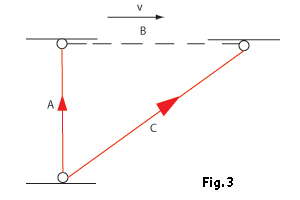 So how much exactly is S’s time seen to be slowing down by F? To answer this question, consider the situation in Fig. 3. As shown, the light clock is moving to the right at a velocity v. At rest, the light clock has a period T. In half that time, when stationary, the light beam travels the distance A, but when moving, it has a slower period T’ because it travels the distance C at the same speed. This means that the ratio of the distances A/C is the same as the ratio of the times taken to traverse them, T/T’. (At the same speed, if you travel twice the distance, it will take you twice as long.) So,
So how much exactly is S’s time seen to be slowing down by F? To answer this question, consider the situation in Fig. 3. As shown, the light clock is moving to the right at a velocity v. At rest, the light clock has a period T. In half that time, when stationary, the light beam travels the distance A, but when moving, it has a slower period T’ because it travels the distance C at the same speed. This means that the ratio of the distances A/C is the same as the ratio of the times taken to traverse them, T/T’. (At the same speed, if you travel twice the distance, it will take you twice as long.) So,
(1) A/C = T/T’
Now while the light beam travels the distance C, the mirrors have moved a distance B to the right. The ratio of these two distances B/C, traveled in the same amount of time, is the same as the ratio of the speeds with which the distances are covered. (Moving for a given time at double the speed just doubles the distance covered.) So,
(2) B/C = v/c
Look at Fig. 3 again, and notice that the sides A, B, and C form a right triangle, so by the Pythagorean Theorem:
(3) A2 + B2 = C2
Dividing both sides by C2 we get:
(A/C)2 + (B/C)2 = 1
Subtracting (B/C)2 from both sides we get:
(A/C)2 = 1 – (B/C)2
Taking the square root of each side we get:
A/C = sqrt ( 1 – (B/C)2 )
Now if we substitute for A/C and B/C from equations (1) and (2) above, we get:
T/T’ = sqrt ( 1 – (v/c)2 )
And finally, inverting both sides, we get:
(4) T’/T = 1 / sqrt ( 1 – (v/c)2 ) = γ (gamma — the relativistic time dilation factor)
Since the speed of light is so high (186,000 miles per second or 300,000 kilometers per second), gamma is not significant at speeds that are common to our experience. For example, even at the speed which the space shuttles must attain to escape Earth’s gravity (11 km/sec), gamma is 1.000000001. At fifty percent of the speed of light (0.5 c), gamma is 1.155. You can confirm these values by plugging in the speeds into the time dilation equation above. One way in which we know that Einstein was correct about time dilation is that particles with known half-lives decay much more slowly when they are accelerated to near the speed of light in particle accelerators. For example, muons, which have a half-life of 1.5 microseconds, are observed to decay in 44 microseconds on average in a CERN experiment which accelerated them to 0.9994 c, at which speed gamma can be calculated using the equation above to be 28.87. In perfect agreement with the theory, 1.5 microseconds multiplied by 28.87 comes out to 44 microseconds, exactly what is seen in the experiment. There are countless other very exact confirmations of relativistic time dilation effects.
LENGTH CONTRACTION
This time, imagine the light clock lying on its side (in other words, Fig. 1 rotated by 90 degrees counter-clockwise). Now the motion of the light pulse is back and forth in the same direction that the whole clock is moving. What happens this time? Well, as the light pulse leaves one mirror and heads toward the other, that mirror advances forward to meet it. This trip is shorter than when the clock is stationary. On the way back, though, the light pulse is chasing a retreating mirror, and the trip takes longer than it would in a stationary situation. This round trip period, T”, is longer than T’ by the factor 1/γ. (This is similar to the case where an airplane traveling across the Atlantic with a steady headwind against it, and then returning with the same wind at its back, will take a longer time for the round trip than if there were no wind at all. I leave the simple math here as an exercise for the reader.)
Now if this were all there is to the story, the amount of time dilation would depend on the orientation of the clock relative to the direction of motion, but then this would violate the Principle of Relativity. What prevents this violation is a shortening of lengths along the direction of motion. The distance between the two mirrors would thus contract by the factor 1/γ, reducing T” to the correct value T’ as it should be. So, lengths are observed to contract along the direction of motion by a factor of 1/γ. Again, this only becomes noticeable at very high speeds, approaching c.
SPACETIME
Newton’s notion of absolute space and absolute time are no longer valid for us. We have seen that measures of time are relative to the observer, as are measures of space. The good news is that different observers of the same reality can agree on something. And this is what it is: we know that
T/T’ = 1/γ
Substituting for 1/γ from equation (4) and squaring both sides we get:
(T/T’)2 = 1 – (v/c)2
Multiplying both sides by (cT’)2 we get:
(cT)2 = (cT’)2 – (vT’)2
Here, vT’ is just the distance L’ that the moving clock travels in time T’. Meanwhile the stationary clock doesn’t go anywhere in time T, so L = 0, and by substituting that L2 = 0 and L’2 = (vT’)2 into the equation above, we get:
(cT)2 – L2 = (cT’)2 – L’2
Here, finally, is a quantity that is the same for both observers. It is not a measure of time or a measure of space; instead, it is a spacetime measure. So we find that in the end, though observers cannot agree about measures of space or time by themselves, it is possible to weave them together into a spacetime measure that everyone does agree on. This is what is meant when it is said that space and time have become interwoven after Einstein.
The account I have followed in explaining special relativity is essentially that used by Richard Feynman (who invented light clocks as a way of explaining SR) and Julian Schwinger. The two of them shared the 1965 Nobel in physics with Sin-Itiro Tomonaga.
Thanks to Margit Oberrauch for all the light clock illustrations.
Have a good week!
My other recent Monday Musings:
Vladimir Nabokov, Lepidopterist
Stevinus, Galileo, and Thought Experiments
Cake Theory and Sri Lanka’s President

